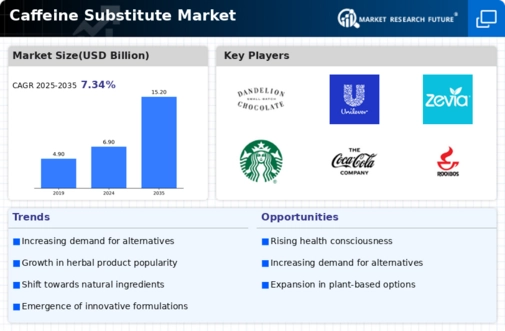Rise of Functional Beverages
The Caffeine Substitute Market is witnessing a surge in the popularity of functional beverages. These products are designed not only to provide energy but also to offer additional health benefits, such as improved focus, enhanced mood, and better hydration. Ingredients like matcha, yerba mate, and various herbal extracts are being incorporated into these beverages, appealing to consumers looking for more than just a caffeine fix. Market data indicates that the functional beverage segment is expected to account for a substantial share of the overall beverage market, with growth rates suggesting a potential increase of 10% annually. This trend reflects a broader consumer demand for products that support overall well-being, thereby influencing the Caffeine Substitute Market.
Increasing Health Consciousness
The Caffeine Substitute Market is experiencing a notable shift as consumers become increasingly health-conscious. This trend is driven by a growing awareness of the adverse effects associated with excessive caffeine consumption, such as anxiety and sleep disturbances. As a result, many individuals are seeking alternatives that provide energy without the negative side effects. The market for caffeine substitutes, including herbal teas and adaptogenic beverages, is projected to grow significantly, with estimates suggesting a compound annual growth rate of over 8% in the coming years. This shift towards healthier options is reshaping consumer preferences and driving innovation within the Caffeine Substitute Market.
Sustainability and Ethical Sourcing
Sustainability has become a pivotal concern for consumers, influencing their purchasing decisions within the Caffeine Substitute Market. As awareness of environmental issues grows, consumers are increasingly favoring products that are sustainably sourced and produced. This trend is prompting manufacturers to adopt ethical sourcing practices, ensuring that ingredients are obtained in a manner that supports environmental conservation and fair trade. The market for sustainably sourced caffeine substitutes, such as organic herbal teas and ethically produced energy drinks, is projected to expand, with estimates indicating a potential market growth of 12% over the next five years. This shift towards sustainability is reshaping the landscape of the Caffeine Substitute Market.
Growing Demand for Personalized Nutrition
The Caffeine Substitute Market is increasingly influenced by the trend towards personalized nutrition. Consumers are seeking products tailored to their specific health needs and lifestyle choices. This demand is prompting manufacturers to develop customizable caffeine substitutes that cater to individual preferences, such as energy levels, dietary restrictions, and health goals. Market Research Future indicates that the personalized nutrition segment is expected to grow at a rate of 9% annually, reflecting a shift in consumer behavior towards more individualized products. This trend is likely to drive innovation and diversification within the Caffeine Substitute Market, as companies strive to meet the unique demands of their customer base.
Technological Advancements in Product Development
Technological advancements are playing a crucial role in the evolution of the Caffeine Substitute Market. Innovations in extraction and formulation techniques are enabling manufacturers to create more effective and appealing products. For instance, advancements in flavor enhancement and preservation techniques are allowing for the development of caffeine substitutes that not only taste better but also retain their health benefits over time. Market analysis suggests that the introduction of new technologies could lead to a 15% increase in product variety within the next few years. This continuous innovation is essential for meeting the diverse preferences of consumers and driving growth in the Caffeine Substitute Market.

















Leave a Comment